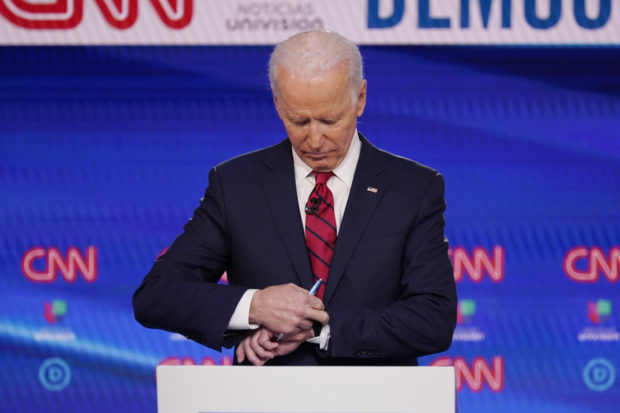Joe Biden, nominee-in-waiting. And waiting. And waiting.
WASHINGTON — In the three weeks since his blowout win in the South Carolina primary, Joe Biden has emerged as the Democratic presidential nominee-in-waiting. But, amid the uncertainty of the coronavirus pandemic, put the emphasis on waiting.

Former Vice President Joe Biden, check his watch during a commercial break as he participates in a Democratic presidential primary debate at CNN Studios, Sunday, March 15, 2020, in Washington. (AP Photo/Evan Vucci)
Biden holds an essentially insurmountable delegate lead over his last remaining rival, Bernie Sanders, yet the Vermont senator remains in the race. And with several states delaying their primaries to avoid the spread of the COVID-19 virus, Biden can’t reach the required majority of pledged convention delegates until May or June.
Yet the former vice president, who proudly calls himself a “tactile politician,” can’t chase those votes in public because he’s essentially confined to his Delaware home like any other American in a quasi-national quarantine. His new campaign manager and her staff are working from home, too.
For now, Biden’s campaign has little choice but to embrace an unprecedented political purgatory.
“Three weeks ago, we were on the verge of collapse as a campaign, so this is a very recent phenomenon,” said Biden senior adviser Anita Dunn, insisting that the 77-year-old candidate remains focused on playing a productive role in the coronavirus response and sewing up a nominating fight that he doesn’t see as finished.
“We will figure out how to put together a general election campaign for this difficult time,” Dunn said.
Biden is confident enough in his position, campaign co-chairman Cedric Richmond said, that he’s started to consider possibilities for a running mate. But Richmond said no vetting process has begun in earnest.
Article continues after this advertisementBiden announced Jen O’Malley Dillon, a veteran Democratic operative, as his new campaign manager on March 12, two days after another round of primary victories widened his lead over Sanders.
Article continues after this advertisementBut in the same gathering where O’Malley Dillon was introduced, she and Dunn told the staff they were shuttering the Philadelphia headquarters and all other Biden offices. With social distancing already taking hold nationally, Biden and his wife, Jill, addressed the group by telephone from their Wilmington home.
The campaign has promised the expected build-out from a relative shoestring staff – growth having been hampered by Biden’s inconsistent fundraising until his recent primary victories – into a national footprint befitting a nominee. But as O’Malley Dillon plots general election strategy, there’s little evidence that mass hiring is imminent.
Andrew Bates, who runs Biden’s “rapid response” communications unit, said the campaign is recruiting “talented people from other presidential campaigns and from elsewhere.” Yet some staffers from defunct campaigns told The Associated Press they’ve had only initial conversations, with no follow-up, and others said they were told the campaign isn’t hiring for their roles in the immediate future.
The people spoke on the condition of anonymity to protect their job prospects.
Digital fundraising efforts continue, with the campaign pushing the usual texts and emails asking for small-dollar contributions.
But high-dollar fundraising events are on hold, including any possibility of a joint fundraising agreement with the Democratic National Committee.
That deal, typically forged between nominees and the party, would allow individual megadonors to contribute hundreds of thousands of dollars each to the party and certain Biden operations, exponentially multiplying the usual $2,800 limits on individual contributions to the Biden campaign.
But the hooks of that fundraising approach are swanky in-person events that allow donors close contact with a would-be president. No one knows when those can happen again.
Meanwhile, Biden and his aides must also react to President Donald Trump and developments in the coronavirus outbreak and response. While challengers to incumbent presidents always play a reactionary role, that’s especially true for Biden, who has built his entire campaign as a juxtaposition with Trump.
But now Trump and his team have an even more dominant media megaphone with an endless loop of White House briefings and congressional machinations in response to the crisis.
As an example, Biden has used two formal addresses to pan Trump’s response as slow and inadequate. Yet since then, the president has signed an initial aid package and endorsed a massive program for direct aid to every adult American — a turn that underscores the difficulty Biden may face countering Trump with a “front-porch campaign” from Delaware.
“I think you’ve seen in the last week, certainly, that the vice president is going to put policy considerations ahead of political considerations,” Dunn said.
The immediate wild cards for Biden, though, are Sanders and the shifting primary calendar.
Though a lengthy primary could afford Biden media spotlights and fundraising hooks he might not otherwise get, Sanders’ lingering presence also delays any effort to unify a party that was damaged in 2016 by a long primary fight between Sanders and Hillary Clinton.
Mathematically, there aren’t enough delegates up in April for Biden to claim the nomination. But more likely, he’d need to win 75% of the delegates from scheduled contests to win the nomination outright on May 19 with Sanders still in the race. If he doesn’t, June 2 would become his more likely clinching date.
At the least, Biden and Sanders have indicated they won’t descend into a bitter fight.
Sanders was at home in Vermont on Thursday, beginning to speak to top supporters about his campaign going forward. His team understands he has virtually no chance at the nomination, but they also said Sanders wants to leave on his own terms.
Aides who spoke on condition of anonymity to discuss the campaign’s thinking said Sanders has given them no indication of his timeline.
In a Thursday email to supporters, Sanders didn’t ask for campaign contributions for the second straight day — an indication he won’t be in the race much longer — but instead sought input on how best to combat the public health and economic effects of the coronavirus.